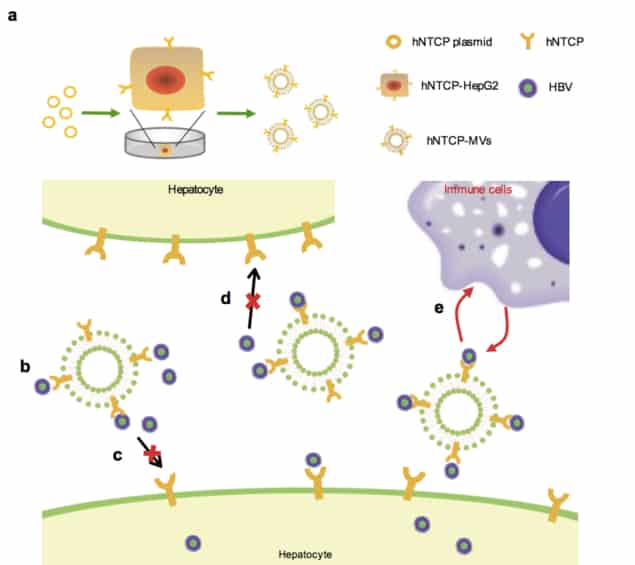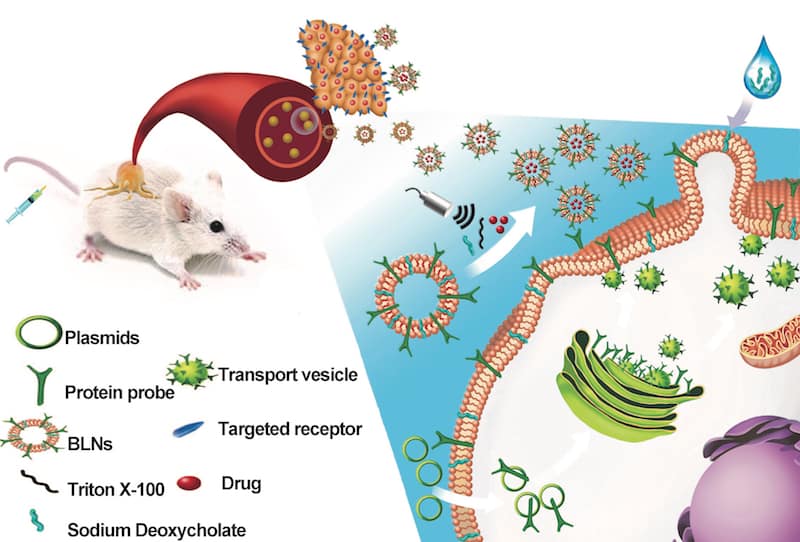|
 
- 现金
- 62111 元
- 精华
- 26
- 帖子
- 30437
- 注册时间
- 2009-10-5
- 最后登录
- 2022-12-28

|
Nanovesicles block hepatitis B 30 Aug 2018 Belle Dumé
 hNTCP-MVs bind to the HBV virion A new biomimetic nanodecoy that can block the hepatitis B virus (HBV) and prevent it from spreading in the body has been developed by a team of researchers at Xiamen University in China and the US National Institutes of Health (NIH). The nanomimic, which is based on cellular membrane vesicles bearing a HBV-specific receptor, could help in the development of next-generation anti-viral strategies in nanomedicine. hNTCP-MVs bind to the HBV virion A new biomimetic nanodecoy that can block the hepatitis B virus (HBV) and prevent it from spreading in the body has been developed by a team of researchers at Xiamen University in China and the US National Institutes of Health (NIH). The nanomimic, which is based on cellular membrane vesicles bearing a HBV-specific receptor, could help in the development of next-generation anti-viral strategies in nanomedicine.
The researchers, led by Gang Liu from the School of Public Health at Xiamen University, engineered their nanoplatform using a nine-transmembrane HBV-specific receptor made from human sodium taurocholate co-transporting polypetide (hNTCP). They then immobilized this receptor on a cell surface, and triggered a process that causes giant plasma membrane vesicles (MVs) to bud from the cell surface. This process occurs in a way that is very similar to how exosomes – tiny membrane-bound spheres – are excreted from cells. The MVs, which have the same content as the cells themselves, have a particular affinity for the HBV virus, and so bind it.
“Catching” the HBV virion “In this study, we designed the hNTCP-MVs as bioinspired artificial nanodecoys to ‘catch’ the HBV virion in a cell culture or mice serum and liver cells,” explains Liu. “The hNTCP-MVs completely bind to the HBV virions and so block further infection from the virus.”
The researchers tested out their nanodecoys on a human-liver-chimeric mouse model, which is an important model for HBV infection and drug evaluation. They made their hNTCP-MVs without any chemical agents, which means that they are biocompatible and non-toxic to cells.
“These structures might be a useful tool to block acute exposure and mother-child transmission of HBV,” Liu tells Physics World, “What is more, since receptor-virus binding does not involves administering any drugs, the technique also overcomes the problem of drug resistance and side effects. If developed into a treatment, it might be particularly beneficial for chronically infected HBV patients who suffer from a high viral load and who generally need large doses of a medicine.”
Immune response might be a problemIt will not all be plain sailing though, he admits. “Although we have shown that hNTCP-MVs can inhibit HBV infection in cell cultures and human-liver-chimeric mice, we know little about their fate in the body. They are much bigger (around 300 nm in size) than the HBV virions (which are around 40-50 nm) and might thus be sensed by antigen-presenting cells, such as macrophages and dendritic cells, and trigger a host immune response.”
Read more

Liposome-like nanovesicles target tumours In this work, the researchers did their experiments on immuno-deficient animals. They say they now plan to extend the study to normal (immuno-competent) animal models to investigate this problem further – and hopefully solve it.
The present research is detailed in Angewandte Chemie 10.1002/anie.201807212.
|
|